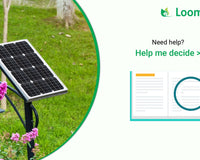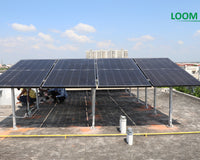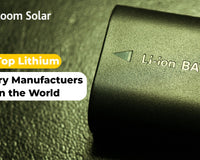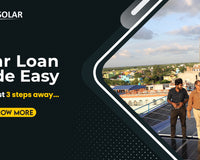48V lithium batteries have many applications in real life, such as home battery energy storage systems, telecommunication batteries, data center backup power supplies, etc. So how much do you know about 48V lithium batteries? We have collected and sorted out some information about 48V lithium batteries, and will take you an in-depth understanding of 48V lithium batteries!
Perfect Energy Storage
2 times battery life, consumes 50% less space, needs no maintenance & takes 60% less recharge time
Off-grid solar systems have actually been around for a very long time, and the original typical systems were mostly all 12V. We obtain a lot of consumers questioning why our systems are all at least 24V or 48V because they're utilized to 12V as the criterion of RV's and also off-grid homes. For small systems, we can concur that 12V could still be ideal, but for medium, to large projects consumers are transitioning over to utilizing 24V or 48V for economical, more efficient setups. Higher voltage battery pack means that it can support larger solar arrays.
What is A 48V Lithium-ion Battery?
The single battery on the market is generally around 3.7v, but many times the operating voltage range is a little larger and there is clearly a problem of insufficient voltage. At this time to increase the battery voltage battery pack and modular battery comes along, and in the many high voltage battery, 48v lithium-ion batteries are commonly used.
Compared with lead-acid batteries, 48V lithium-ion batteries have the advantages of small size, light weight, strong temperature adaptability, high charging and discharging efficiency, safety and stability, long service life, energy saving and environmental protection.
48V lithium-ion batteries can be divided into ternary lithium batteries, lithium iron phosphate batteries, lithium titanate batteries according to the cathode material.
48V Lithium ion Battery Price
48V lithium-ion battery is made by combining multiple lithium cells by connecting them in series and parallel, because the efficiency and life of the battery is not very good if the manufacturing of a single cell is a 48v lithium battery.
48V lithium-ion battery price estimation formula
Single lithium battery cell price x (3.2 ~ 3.7V * n = 48v) * m (the number of cells in parallel) + protection plate price + shell price + auxiliary material price General single lithium cell voltage of 3.2 ~ 3.7V, its price will vary because of the different materials and processes used in the production of lithium battery manufacturers.
48V Lithium-ion Battery Protection Board
48V lithium-ion battery protection board, i.e. the circuit board that plays a protective role. It is mainly composed of electronic circuits, which can accurately monitor the voltage of the battery cell and the current of the charging and discharging circuit at all times under the environment of -40℃ to +85℃, and control the on/off of the current circuit in time.
Li-ion battery protection board can play the role of charging and discharging protection for series and parallel connected battery pack, and at the same time can detect the over-voltage, over-current, over-temperature, under-voltage and short-circuit status of each single battery in the battery pack to prolong the service life of the battery and avoid the damage of the battery due to over-discharge. Lithium battery protection board is an indispensable component of lithium battery.
48V Lithium-ion Battery BMS
The 48V Li-ion battery management system (BMS) determines the status of the entire battery system by detecting the status of each individual cell in the Li-ion battery pack, and implements corresponding control adjustments and strategies for the Li-ion battery system based on their status to achieve charge and discharge management of the Li-ion battery system and each individual cell to ensure safe and stable operation of the Li-ion battery system.
48V Lithium Battery BMS Features
● Lithium-ion battery management system consists of management host (CPU), voltage and temperature collection module, current collection module and communication interface module.
● It can detect and display the total voltage, total current and reserve power of the lithium-ion battery pack; the voltage of any single cell and the temperature of the battery box; the highest and lowest single cell voltage and cell number, the highest and lowest temperature, and the charge and discharge amount of the battery pack.
● The lithium-ion battery host also provides alarm and control output interface for over-voltage, under-voltage, high temperature, low temperature, over-current, short circuit and other limit conditions.
● RS232 and CAN bus interfaces are provided to read all the information on the Li-ion battery management system directly on the computer.
48V Lithium ion Battery use Precautions
1. Lithium-ion battery stored for a long time without use, should be maintained at 50%-60% charge state, should be replenished once every 3 months, and should be charged and discharged once every six months.
2. During transportation, care should be taken to prevent moisture and humidity, and avoid extrusion and collision to avoid damage to the lithium-ion battery.
3. In low temperature, it should not be lower than 0°C. Storage at a temperature of 5°C to 10°C is optimal.
4. Prohibit the use or placement of lithium-ion batteries under high temperature (hot sunlight or very hot car), otherwise it may cause battery overheating, fire or functional failure, shortened life.
5. Prohibit storage in places with strong static electricity and strong magnetic fields, otherwise it is easy to destroy the battery safety protection device, bringing unsafe hidden danger.
6. If the lithium-ion battery emits an odor, heat, discoloration, deformation or any abnormalities occur during use, storage or charging, immediately remove the battery from the device or charger and discontinue use.
7. In the case of lithium-ion batteries, a monthly power loss of 3% to 5% is possible. Self-discharge is temperature dependent and will be higher as the temperature rises.
8. Complete discharge is the "squeezing" of a battery until it no longer produces any current. Squeeze out any current. In this case, the voltage will drop to 0 volts. If this state is maintained. A chemical reaction occurs at the electrodes of the battery, rendering it partially or completely unusable.
9. Lithium-ion batteries can be used in the temperature range of 10°C to +55°C. However, charging can only be done at a battery temperature of +5°C to +45°C.
48V Lithium-ion Battery vs. Lead-acid Battery
Energy density by weight
At present, the energy density of lithium battery is generally 200~260wh/g, while that of lead-acid is generally 50~70wh/g. The weight energy density of lithium battery is 3~5 times that of lead-acid, which means that the capacity of lithium battery is three to five times stronger than that of lead-acid battery under the same weight, so lithium battery has absolute advantage in energy storage.
Volume energy density
Since the volume energy density of Li-ion battery is usually about 1.5 times that of lead-acid battery, Li-ion battery is about 30% smaller than lead-acid battery in the same capacity.
Service life
The most popular lithium battery materials are lithium ternary and lithium iron. For example, ternary lithium batteries usually have 1000 cycles, lithium iron phosphate batteries have more than 2000 cycles, and lead-acid batteries usually have 300-350 cycles. Then it means that the life of lithium batteries is about 3-6 times that of lead-acid batteries.
Price Cost
Lead-acid batteries are currently cheaper than lithium batteries, which are about three times more expensive than lead-acid batteries. However, by lifetime analysis, lithium batteries have a longer lifetime if the same cost is used.
Environmental Protection
Lead-acid batteries are very polluting, while lithium batteries are relatively greener in terms of production and recycling.
How Long will A Fully Charged 48V Lithium-ion Battery Run My Home?
The range of a 48V Li-ion battery is related to the capacity of the battery itself (Ah) and the total power of the household appliances (W). Assuming you are using a 48V 200Ah solar home battery and the total power of the household appliances is 1800W, then the running time of your home is 48V*200Ah/1.8kW=5.3h.
How Many Hours Does It Take To Charge an 48V Lithium Battery to Full?
charging time and voltage does not have much to do with.
Mainly depends on the capacity of the lithium-ion battery and the power of the charger, charging time = lithium battery capacity ÷ charging current
For example, 48V 5kWh lithium-ion battery, assuming that the maximum charge current allowed is 50Ah, then the theoretical charging time of 4 hours, that is, 200Ah ÷ 50A = 4h, but the actual charging constant current to constant voltage mode, the trickle charge at the end takes longer, so under normal circumstances are in about 5 hours. Similarly, if the allowed charging current is 20Ah, it takes 200Ah ÷ 20A = 10h, but the same trickle time, so it is about 12 hours or so.
48V Lithium-ion Battery Can Not Be Charged into How To Do?
● Whether the solar panel output parameters are normal, voltage, current, etc.
● hether the charger line is normal, whether the connector is disconnected
● whether the 48V lithium battery is bad, you can test whether the open circuit voltage of the battery is normal.
● Consult the lithium battery manufacturer.
48V 13 String and 14 String Difference
NCA only divided into 13 or 14 strings, lithium iron phosphate is 16 strings
But the NCA 13 string discharge platform is significantly lower than 48V, the speed is slow, 14 string good
13 string full voltage 13 * 4.2 = 54.6V, rated voltage 13 * 3.7 = 48.1V, as of voltage 13 * 3.2 = 41.6V
14 string full voltage 14*4.2=58.8V, rated voltage 14*3.7=51.8V, as of voltage 14*3.2 = 44.8V
13 series can be better compatible with lead-acid battery electric car, lead-acid battery electric car normal is 12*4= 48V, as of voltage 10.5*4 = 42V
LiFePO4 / LFP is commonly referred to as "iron phosphate", the nominal voltage of each cell is 3.2V. This means that to make a 48V battery pack requires 16 LiFePO4 cells, 16 strings full voltage 16*3.2 = 51.2V, LiFePO4 is considered to be the most fireproof, and their LiFePO4 is considered to be the most fire resistant, and they typically last twice as long as ordinary NCA/NCM 18650 battery packs.













3 comments
Satish Shetty
I want to install solar system with 3 panel 445watt solar panel with 48v Loom Solar CAML lithium battery to run 1.5ton split inverter AC and 1fan for 8hrs
Kwame Kyeremeh
How can I get a 48v 10Ah lithium ion battery for my Erider scooter? I can give the specifications if needed. I am in Ghana.
Rajeev grover
Camel battary rate